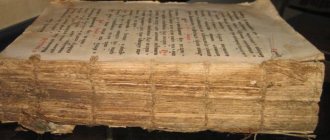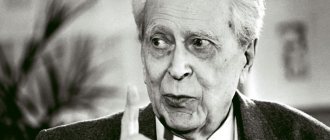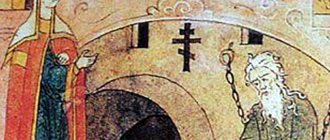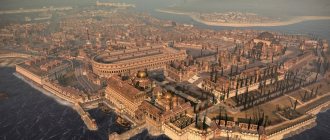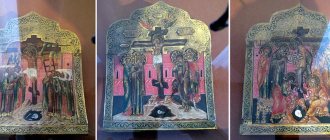Freedom is a luxury that not everyone can afford.
Otto von Bismarck
The Uglich case is the name of a set of events that were aimed at studying the mysterious circumstances that accompanied one of the significant events of that era - the death of one of the sons of Ivan the Terrible - the young Tsarevich Dmitry. This name of the case is due to the place where the tragedy occurred on May 15, 1591 - the city of Uglich. There are several versions of the death of the prince, but before considering them, it is necessary to understand what events in Rus' preceded this mysterious case.
Illegitimate
Strictly speaking, the youngest son of Ivan the Terrible bore the title “prince” only conditionally, and had no rights to the throne.
His mother, Maria Nagaya , was, according to different versions of historians, either the sixth or seventh wife of the king. The Church did not recognize this marriage as legal, which means that the child born on October 19, 1582 could not be the legal heir to the throne.
Dmitry Ivanovich was the full namesake of his older brother, the first-born of Ivan the Terrible. The first Dmitry Ivanovich passed away without even living a year. The exact circumstances of his death are unknown - during his father’s trip on a pilgrimage, the baby either died of illness or drowned as a result of an accident.
The second Dmitry Ivanovich outlived his father - when Ivan the Terrible died, his youngest son was about one and a half years old.
Fyodor Ivanovich, who ascended the throne , ordered to send his stepmother and brother to Uglich, proclaiming him an appanage prince.
Article on the topic
In bed with the king. Ivan the Terrible and all his women
Moving to Uglich
The life tells that after the death of the crowned father and the election of Fedor, another royal son, to the throne, the boy and his mother were sent to Uglich, receiving this city as a reign.
Compared to other wives, who were either immediately killed or forcibly tonsured as nuns in distant monasteries, the move took place on good conditions: Tsarevich Dmitry’s mother Maria was accompanied by a retinue and servants, her boxes were full of luxurious clothes, jewelry, food and drink.
And they began to live in the princely palace, built under Prince Andrei the Bolshoi. Mother Maria Nagaya and her royal son lived in these chambers in 1584-1591.
The Great Ambitions of the Naked Clan
Tsarevich Dmitry became the last appanage prince in Russia, and his rights were seriously limited. Uglich was governed by clerk Mikhail Bityagovsky , appointed by the tsar.
Relations between Fyodor Ivanovich's entourage and Nagimi were, to put it mildly, strained.
By sending the dowager queen and prince to Uglich, they were given to understand that they would not tolerate any claims to the throne on their part. The truth was on the side of Nagikh’s opponents, since, as already said, Dmitry was considered illegitimate.
The Nagikh clan, starting with the queen, was extremely hurt by this state of affairs, hoping to occupy high government positions.
But they still had hope. Fyodor Ivanovich was not in good health and could not produce an heir. And this meant that Dmitry, despite his illegitimacy, remained the only direct heir to the throne.
The last one before the Troubles. The unnoticeable life of Tsar Fyodor Ioannovich Read more
Could it have been different?
Let's backtrack a little. It is impossible not to recognize the outstanding merits of Vasily III and Ivan the Terrible in destroying the Rurik dynasty. Vasily had four younger brothers, three of them died childless. The reason is quite simple: they were forbidden to have children until the sovereign acquired an heir. And since the process dragged on, the dynasty became greatly impoverished. The survivors were solemnly finished off by Vasily's widow Elena Glinskaya and Ivan the Terrible.
Ivan Vasilyevich did a great job: he killed his cousin Vladimir Staritsky with almost his entire family, and at the same time his own son Ivan. As a result, at the time of the death of Ivan the Terrible, there were only three living representatives of the dynasty: Fyodor, Tsarevich Dmitry and the youngest daughter of Vladimir Staritsky Maria, who was soon tonsured as a nun.
Murder of Dmitry. (wikipedia.org)
The situation looked like this: between an ambitious boyar who wants to take the throne and his goal stood a not fully capable and not very healthy king and a little boy. However, within the framework of this article we are not hinting at anything. Let's just say that it is customary to keep heirs, even if they are brothers and not sons, to themselves. Fedor sent Dmitry to Uglich. It seems to be for safety, but it just looks like an opal. In general, we have every reason to assert that Dmitry’s life was in danger and that his right to the throne could most likely be violated.
Two things need to be remembered here. Dmitry is the son of Ivan the Terrible, either from his sixth or seventh marriage. You can count in different ways, but in this case it doesn’t matter, because the church allowed a maximum of three, although the king, due to his position, was allowed a fourth in addition to this. But not the seventh or even the sixth. And this circumstance already created obstacles on Dmitry’s path to the throne.
The second circumstance: the clerk Mikhail Bityagovsky was vigilantly watching Nagimi in Uglich. This was not security for the safety of the royal brother, but espionage and constant monitoring of a dangerous competitor. It was Bityagovsky who managed the Uglich inheritance allocated for Dmitry, although the prince and his mother lived in the royal chambers. All this suggests that Dmitry’s death does not look accidental. Under the circumstances, he was dangerous not only as his brother’s heir, but also as a competitor to Fedor himself. Because the tsar is weak, and here there is a completely healthy and cheerful guy, who, moreover, even at a young age showed the makings of the character of his formidable father. That is, there was a risk that Dmitry would unite the enemies of Fedor and especially the enemies of the Godunov family, of which there were many.
“He takes pleasure in seeing his throat cut and blood flowing from it.”
Information about Dmitry himself is contradictory. Russian historians, for reasons that will be discussed below, painted the image of a kind of angel endowed exclusively with virtues.
Foreigners wrote somewhat differently. The Englishman Giles Fletcher , who wrote a book about his trip to Russia, reported: “The Tsar’s younger brother, a child of six or seven years old (as was said before), is kept in a remote place from Moscow, under the supervision of his mother and relatives from the house of Nagikh, but (as heard) his life is in danger from the attempts of those who extend their sights on possessing the throne in the event of the childless death of the king. The nurse, who had tasted some dish before him (as I heard), died suddenly. The Russians confirm that he is definitely the son of Tsar Ivan Vasilyevich, by the fact that in his young years all the qualities of his father begin to be revealed in him. He (they say) takes pleasure in watching sheep and livestock in general being killed, in seeing a throat cut while blood flows from it (whereas children are usually afraid of this), and in beating geese and chickens with a stick until they They won’t die.”
In addition to Dmitry’s cruelty, with which he reminded his contemporaries of his father and older brother Ivan, the topic of a possible assassination attempt on the prince also comes up here. This is extremely important in connection with the events that occurred subsequently.
Article on the topic
The executioner's son-in-law is also an executioner at heart. Boris Godunov - Russia's missed chance?
Great Hunger
The death of the last sovereign from the Rurik dynasty opened the way to the kingdom of Boris Godunov, who was actually the ruler of the country even when Fyodor Ioannovich was alive. By that time, Godunov had gained a popular reputation as the “killer of the prince,” but this did not bother him much. Through cunning manipulations, he was nevertheless elected king, and almost immediately began with reforms.
In two short years, he carried out more changes in the country than previous kings had done in the entire 16th century. And when Godunov already seemed to have won the people’s love, a catastrophe struck - from unprecedented climatic cataclysms, the Great Famine came to Rus', which lasted for three whole years. The historian Karamzin wrote that people “like cattle plucked grass and ate it; the dead were found to have hay in their mouths. Horse meat seemed like a delicacy: they ate dogs, cats, bitches, and all sorts of unclean things. People became worse than animals: they left their families and wives so as not to share the last piece with them.
They not only robbed and killed for a loaf of bread, but also devoured each other... Human meat was sold in pies in the markets! Mothers gnawed at the corpses of their babies!..” In Moscow alone, more than 120,000 people died of hunger; Numerous gangs of robbers operated throughout the country. Not a trace remained of the people's love for the elected tsar that had been born - the people again talked about the curse of Tsarevich Dmitry and about the “damned Boriska”.
Fatal May 15
On May 15, 1591, Tsarevich Dmitry was found dead in the courtyard of the palace. The boy received a fatal wound to the neck.
The mother of the deceased, Maria Nagaya, as well as her relatives, announced that the prince was stabbed to death by the people of clerk Mikhail Bityagovsky on orders from Moscow. An alarm bell sounded over Uglich. An angry crowd tore to pieces the alleged murderers - Osip Volokhov , Nikita Kachalov and Danila Bityagovsky , the son of a clerk. Following this, they dealt with Mikhail Bityagovsky himself, who was trying to calm the crowd.
From the point of view of the tsarist authorities, a riot occurred in Uglich. Tsar Fyodor Ivanovich's brother-in-law Boris Godunov , who was at that time the de facto head of government, immediately sent a commission of inquiry to Uglich. Vasily Shuisky was appointed head of the commission .
The investigation into the death of Tsarevich Dmitry is unique in that the investigation materials have survived to this day. About 150 people were interrogated - almost everyone who was involved in the events of May 15.
In the name of Monomakh's cap. Crime and punishment of Tsar Vasily Shuisky Read more
The myth of the murder of Tsarevich Dmitry Uglitsky
Tsarevich Dmitry. Painting by Mikhail Nesterov, 1899
Prologue of the Great Troubles
Tsarevich Dmitry Ivanovich (Dimitri Ioanovich) was born in October 1582 from the sixth wife of Sovereign Ivan Vasilyevich, Maria Nagoya.
At that time, the church considered only the first three marriages legal, so Dmitry could be considered illegitimate and excluded from contenders for the throne. However, Tsar Fedor Ivanovich was weak in mind and health, and was under the tutelage of the Boyar Duma, and then of his brother-in-law Boris Godunov. If he did not have a male heir left, then Dmitry could become the new king. Therefore, in Moscow they watched Dmitry and his relatives warily. After the death of Ivan the Terrible in 1584 and the accession of Fyodor Ivanovich to the throne, the boy and his mother were sent to Uglich by the regency council, receiving it as an inheritance. Dmitry was considered the ruling prince, he had his own court. However, real power was in the hands of “service people” sent from Moscow under the leadership of clerk Mikhail Bityagovsky, who monitored the Uglich court.
The circumstances of the death of Tsarevich Dmitry Ivanovich still remain controversial and not fully clarified. On May 15 (25), 1591, the former queen Maria Nagaya and her son Dmitry celebrated mass in the Transfiguration Cathedral in the Uglich Kremlin. Then Maria, with her 8-year-old son and the courtiers, went to the stone palace. There the prince's dress was changed, and he went to play in the Kremlin courtyard. Almost at noon the alarm bell sounded in the Kremlin. The townspeople who came running saw the lifeless body of the prince with a wound on his throat. Maria and her brothers Mikhail and Gregory set the crowd against local officials. They believed that the Uglich prince was stabbed to death by Osip Volokhov (the son of the prince’s mother), Nikita Kachalov and Danila Bityagovsky (the son of clerk Mikhail, who looked after the royal family). That is, in fact, on the direct order of the Moscow government. A riot began. The townspeople tore the alleged murderers to pieces.
Four days later, an investigative commission consisting of Metropolitan Gelasius, the head of the Local Prikaz, Duma clerk Elizariy Vyluzgin, okolnichy Andrei Petrovich Lup-Kleshnin and boyar Vasily Shuisky (the future Tsar of Rus') arrived in Uglich. The commission decided that the cause of the prince’s death was an accident.
As a result, the Uglich residents were punished in accordance with the degree of participation in the murders. Several dozen people were repressed: some had their heads cut off, others had their tongues cut off, 60 families were exiled to Siberia. The bell in the Church of the Savior, which the rioters rang, was also “punished.” He was publicly flogged, his ear was cut off, his tongue was torn out and he was exiled to Tobolsk, where he was recorded as “the first inanimate exile.”
In Tobolsk, the bell was installed in the Sofia Bell Tower. Then, after the fire, he stood on the ground. At the request of the Uglich residents, in 1892 the bell was returned to Uglich. The Nagikh brothers, in addition to the riot in Uglich, were accused of setting fire to houses in Moscow and were sent to cities. Maria Nagaya “for not looking after her son” was sent to the Nikolovyksinsk hermitage (monastery). She was tonsured a nun under the name of Martha. Later they were transferred to the Goritsky Resurrection Convent on the Sheksna River.
Actually, the Uglich story would have been forgotten at this point. Moreover, soon Queen Irina conceived again. This time she carried the child to term. However, Tsar Fedor had a daughter, Fedosya. She was often ill and died in January 1594. The dynasty came to an end, which became a reason for rumors.
Chambers of the Uglich princes, built in the 1480s by Prince Andrei Vasilyevich in the Uglich Kremlin on the banks of the Volga
Uglich case
The greatest attention to the Uglich case was shown in the first half of the 19th century after the publication of “History of the Russian State” by N. M. Karamzin and the drama “Boris Godunov” by A. S. Pushkin.
For more than two centuries of controversy, historians and publicists have not come to a consensus on this event. There are three leading versions of the Uglich case. The investigative commission interviewed about 150 people who took part in these events. The matter was announced by Metropolitan Gelasius at the Consecrated Council. The conclusion is an accident. The prince developed epilepsy and died during convulsions. According to nurse Arina Tuchkova:
“She didn’t save him, when a black illness came to the prince, and at that time he had a knife in his hands, and he stabbed himself with the knife, and she took the prince in her arms, and the prince in her arms was gone.”
These words were repeated by other witnesses with some differences. Many professional historians, researchers of this period of Russian history, in particular, S. F. Platonov and R. G. Skrynnikov, believed that the investigative commission made the right conclusion.
The second version is that Dmitry remained alive and was hidden by Nagimi so that he would not be killed. In 1605, False Dmitry, who proclaimed himself a “miraculously saved” prince, seized the Moscow throne and reconsidered the Uglich case. Maria Nagaya recognized him as her son, other participants in the investigation immediately changed their testimony. The reunion of mother and “son” took place in the village of Taininsky in front of a huge crowd. The “Tsar” jumped off his horse and rushed to the carriage, and Martha, throwing back the side curtain, took him into her arms, and both were sobbing. The salvation of the Uglich prince was explained by the intervention of a certain doctor.
The third version - the murder of Dmitry Uglichsky on the orders of Boris Godunov - was accepted already during the reign of Vasily Shuisky. The new government sought to blame all the troubles of the Time of Troubles on the Godunov family. The new ruling dynasty, the Romanovs, also supported this version. It became official. The church also supported this. The classic plot was outlined in Karamzin’s “History of the Russian State”. Then in “History” by S. M. Solovyov. Westerners who “created” the classical, pro-Western version of Russian history. There are other versions. For example, it is possible that it was murder by negligence.
Icon "Tsarevich Demetrius of Uglich in his life." State Historical Museum. Left: 1. The prince is taken out of the palace 2. The murder of the prince, the nurse tries to save Dimitri 3. The Bityagovskys on horseback try to escape from Uglich. Right: 1. The sexton rings the bell. The Bityagovskys are trying to knock down the door in the bell tower 2. Residents of Uglich stone the murderers of Dmitry 3. The city of Uglich
The truth is somewhere near
Obviously, the version of “miraculous salvation” is most unlikely.
In Uglich, almost everyone knew the prince by sight. Numerous mothers, other servants, boy comrades, nobles, and representatives of the administration could not identify themselves. And what about the investigative commission from Moscow?
The naked ones clearly could not bribe or somehow convince investigators from the capital to assist in their deception. The intellectual ceiling of their “team” was low to start such a long-term political game with far-reaching goals. It is clear that after the murder of the fake child,” exile or imprisonment of Nagikh will follow. How can one then prove that the prince is true? The Moscow government will declare him an impostor and impale him.
The version of Boris Godunov's conspiracy is more plausible. According to it, the villain Godunov planned to kill the Uglich prince. As the historian S. M. Solovyov wrote, at first they planned to poison Dmitry, but it didn’t work out. Then they planned an evil deed. Deacon Mikhail Bityagovsky took charge of it. His son Danila, nephew Nikita Kachalov, and the son of the Tsarevich’s mother Osip Volokhov went with him to Uglich. Queen Maria sensed something was wrong and began to take even more care of the prince. But on May 15, at noon, for some reason she lost her attention, and Volokhov’s mother, who was in the conspiracy, took the child into the yard. The killers were already on the porch. Volokhov stabbed him in the throat and ran away. The nurse tried to protect the prince and began to scream. Bityagovsky and Kachalov beat her half to death and cut the child to death. Then turmoil arose and the conspirators were killed. The commission members allegedly knew what really happened. But, having arrived in Moscow, Shuisky and his comrades told the tsar that Dmitry had stabbed himself.
It is worth remembering that Godunov, although he had great power in the Russian state under Tsar Fedor, was not an absolute ruler. He had his supporters, but most of the Boyar Duma, including the ancient Shuisky family, were happy for any reason to overthrow the powerful temporary worker. And here is such a scandal! The murder of the prince, in which Godunov's supporters were involved. Nagi should not have killed possible perpetrators, but taken them alive for interrogation in order to find the customer. However, Bityakovsky and his comrades were killed, that is, they hid their ends in the water.
It is also obvious that in 1591 Godunov did not have to kill Dmitry. Tsar Fedor was 34 years old, which means he still had time to give birth to an heir. That same year, Tsarina Irina became pregnant, but a girl, Fedosya, was born. Interestingly, Godunov was also blamed for her death. In addition, Boris had more convenient methods than outright murder. I. Link, after accusing Nagikh of treason or witchcraft, etc. Dmitry would have been isolated, placed under the care of faithful people in a quiet place, and he would soon have given his soul to God.
The prince died in an accident
Thus, the most reasonable version is an accident.
Dimitry Uglichsky suffered from epilepsy. Severe seizures occurred. The last attack lasted several days and ended with the death of the prince on May 15, 1591. Another important detail is that the prince loved playing with weapons. At that time, the children of feudal lords and princes played with real weapons from an early age; this was an element of military education. Almost the entire life of the nobility is war. In European museums there are a lot of children's weapons - knives, daggers, swords, sabers, axes, etc. By the way, in the Middle Ages there were even tournaments and fights among children and teenagers. Deaths in such fights were commonplace.
On May 15 (25), the Uglich prince played poke. The rules of the game are simple - you need to take the tip with the blade up and throw it into a circle outlined on the ground. Suddenly, Dimitri, who was holding the knife, suffered an attack of “episode illness.” The boy fell and got a prick in his throat. On the neck, under the skin, there are the carotid artery and jugular vein. If damaged, their death is inevitable.
Another option is also possible: during an attack, the patient throws a weapon at loved ones or attempts suicide. Therefore, eyewitnesses of the event were somewhat confused in their testimony: they could not determine when the prince injured himself, during the fall, or when he was convulsing on the ground. They said one thing - Dmitry wounded himself in the throat.
Maria and her brothers, in their minds, should not have called for reprisals against possible murderers. On the contrary, grab them and carry out a “righteous search.” The Naked are doing everything to hide the traces of the accident and “bring Godunov and his people under the monastery.” After all, according to the Nagikh version, Osip was the murderer of the prince. If he had really killed Demetrius, he would have faced the most severe torture, and then a painful execution. This was well known to everyone. But Maria Nagaya and her brothers are doing everything to hide traces of the incident. They organize a riot and eliminate unwanted witnesses.
The Boyar Duma appointed Vasily Shuisky to lead the investigation in Uglich. By this time, his disgrace was lifted and he returned to the Boyar Duma. Vasily was the most cunning and resourceful of the Shuisky family. Previously headed the Judicial Order. Obviously, he did not support Godunov. Metropolitan Gelasius of Krutitsa was also not a servant of Godunov. Andrei Kleshnin had a good relationship with Godunov, but at the same time he was then Mikhail Nagoy. The head of the Local Prikaz, Vyluzgin, occupied one of the main positions in the then “government”.
The members of the commission belonged to different court groups, everyone kept an eye on each other and intrigued. Obviously, if there was an opportunity to accuse Godunov, the Shuiskys and other boyars would use this chance.
The commission members interviewed many people. First of all, they carefully examined the bodies of the prince and the victims of lynching. No one had even a shadow of a doubt that this was Dimitri Ivanovich and not a fake boy.
The funeral service was conducted personally by the Metropolitan. It quickly became clear that the knives and clubs were planted on the corpses of the Bityakovskys and their comrades on the orders of the Nagikhs. Mikhail Nagoy did not want to confess, but he was exposed. Grigory Nagoy immediately admitted to preparing “evidence.”
Investigators quickly identified the names of all direct witnesses. Volokhova's mother, Arina Tuchkova, Kolobov's bed-maid, and four boys who played knife with Dmitry gave testimony. The boys described everything accurately and well: while playing poke, the prince became ill and cut himself. Osip Volokhov and Danila Bityagovsky were not in the backyard at that time (the Bityagovskys were having dinner at home at that time). These testimonies were confirmed by Kolobova, the mother of Volokhov and Tuchkov. The nurse was especially sad for the prince and blamed herself for everything.
Then an eighth witness was found. The housekeeper Tulubeev said that the lawyer Yudin, who stood in the upper chambers and looked out the window as the boys played, told him about the death of the prince. Yudin himself saw how the prince killed himself. But he knew that the Nagi were insisting on murder, so he decided to avoid testifying.
Testimony was given even before the repressions. Investigators did not pursue witnesses to the death of the prince and the riot.
The Church Council on June 2, 1591 unanimously approved that Tsarevich Dmitry died “by God’s judgment.” And the Naked are guilty of organizing a riot and the death of innocent people.
The investigation established
As a result of the investigation, the following was established. The prince had long suffered from attacks of “black sickness” - epilepsy. The last seizure occurred on May 12, that is, three days before his death. Then Dmitry felt better, and on May 15, after attending mass, his mother allowed him to take a walk in the courtyard.
With the prince were his mother Vasilisa Volokhova , nurse Arina Tuchkova , bed-wife Marya Kolobova and four of Dmitry’s peers, the sons of the nurse and bed-nurse Petrusha Kolobov , Ivan Krasensky and Grisha Kozlovsky . The boys played “poke” - this ancient Russian game is most reminiscent of the so-called “knives”, which are still played today. In general terms, the essence of the game is to throw a sharpened metal object (knife or rod) into the ground in a certain way.
In Dmitry’s hand there was either a knife or a pile (a sharpened tetrahedral nail). At this moment, the prince was overtaken by a new attack of epilepsy. During the attack, the boy involuntarily stuck the point into his throat, which became the cause of death.
The final conclusion of the investigative commission was that Tsarevich Dmitry died as a result of an accident. The consecrated council, headed by Patriarch Job, approved the results of the investigation.
Article on the topic
Rurikovich: the beginning and end of the dynasty
Time of Troubles
Bloody civil strife, the absence of a central government, lawlessness... As a result, power will end up in the hands of foreign interventionists - Polish magnates who will come to Russia with their troops and their liar. How did it happen that a Western protege ended up on the Russian throne, and the once mighty power plunged into a state of continuous civil war for 15 years, torn apart by Polish troops from the west and Swedish troops from the north? Centuries later, we can say that this was the result of a multi-move complex game played by the West against Russia.
Weapons against Godunov
As punishment for the riot, Maria Nagaya was tonsured a nun under the name of Martha, her brothers were sent into exile, and the most active participants in the riot among the townspeople were executed or exiled to Siberia.
But that was just the beginning of the story. In 1598, without leaving an heir, Tsar Fyodor Ioannovich died. The Rurik dynasty came to an end. The Zemsky Sobor elects a new Tsar - Boris Godunov.
For opponents of the new monarch, the “Uglich case” becomes an excellent tool for generating distrust of Godunov among the people. Vasily Shuisky becomes one of the main attackers. The former head of the investigation into the death of Tsarevich Dmitry himself dreams of taking the throne, so he intrigues against Godunov with all his might.
And then False Dmitry I , supposedly a prince who miraculously escaped from the murderers. Many believe him, and as a result, in 1605, after the death of Boris Godunov and the reprisal of his son Fedor , the impostor took the throne. Vasily Shuisky once again changes his testimony and recognizes False Dmitry as the legitimate prince.
Ukrainian start of False Dmitry. Who supported the first Russian impostor Read more
How did this turn out for ordinary citizens?
We can say that the mysterious death of the Tsar’s youngest son became the beginning of the Time of Troubles for Russia. The excited crowd, who had gathered at the alarm, without much understanding, immediately beat to death those whom they considered guilty of this death. A commission immediately arrived from Moscow to investigate this tragedy, the death of Tsarevich Dmitry Ivanovich in Uglich.
After interviewing eyewitnesses, the conclusion of the investigation was as follows: the death of Tsarevich Dmitry, who died in Uglich, was the result of an accident. But despite this conclusion of the high commission, 200 residents of the city were executed, and 60 families, either because they did not save the royal person, or because they committed lynching without trial: they were exiled to Siberia.
There the Uglich residents became builders and the first settlers of the Pelymsky fort. And Queen Maria, the mother of Dmitry of Uglich, was exiled to a distant monastery on Vyksa and there she was forcibly tonsured a nun.
Saint vs impostor
But already in 1606, Vasily Shuisky becomes the head of a new conspiracy, as a result of which False Dmitry will be killed, and the ambitious boyar will finally sit on the throne.
However, Shuisky also faces the problem of the “miraculously saved” prince, now in the form of False Dmitry II .
The Tsar understands that the story of the Tsarevich must be ended, and in such a way that the masses believe that he is dead.
The prince was buried in Uglich, where few people could see his grave. Vasily Shuisky decides to rebury him in Moscow, and not just as a deceased member of the royal family, but as a holy martyr.
This was an elegant solution - in the presence of the venerated relics of a saint, the myth of a “miraculous salvation” would be much more difficult to use.
By order of the tsar, a special commission was sent to Uglich under the leadership of Metropolitan Filaret , father of Mikhail Romanov , the future founder of the new royal dynasty.
When the grave was opened, the relics of the prince were found incorrupt and emitting incense. The dead prince was clutching a handful of nuts in his hand - according to the version of the murder, the criminals caught the child while he was playing with nuts.
The relics were solemnly reburied in the Archangel Cathedral of the Kremlin. Those who came to the prince’s tomb began to claim miraculous healings, and in the same year he was canonized.
Article on the topic
Tsarevich and executioner. Why was the son of Ivan the Terrible canonized?
The Last Curse
The Troubles in Rus' ended only in 1613 - with the establishment of the new Romanov dynasty. But did Dmitry’s curse dry up along with this? The 300-year history of the dynasty says otherwise. Patriarch Filaret (in the world Fyodor Nikitich Romanov), the father of the first “Romanov” Tsar Mikhail Fedorovich, was in the thick of the “passion for Dmitry.”
In 1605, he, imprisoned by Boris Godunov in the monastery, was freed as a “relative” by False Dmitry I. After Shuisky’s accession, it was Philaret who brought the “miraculous relics” of the prince from Uglich to Moscow and planted the cult of St. Dmitry of Uglitsky - in order to convince Shuisky that False Dmitry, who once saved him, was an impostor. And then, standing in opposition to Tsar Vasily, he became the “nominated patriarch” in the Tushino camp of False Dmitry II.
Filaret can be considered the first of the Romanov dynasty: under Tsar Mikhail he bore the title “Great Sovereign” and was actually the head of state. The Romanov reign began with the Time of Troubles and the Time of Troubles ended. Moreover, for the second time in Russian history, the royal dynasty was interrupted by the murder of the prince. There is a legend that Paul I locked in a casket for a hundred years the prediction of Elder Abel concerning the fate of the dynasty. It is possible that the name of Dmitry Ioannovich appeared there.
What you don't want to believe
Here historians walk around the edge, for the blessed Tsarevich Dimitri of Uglitsky, the miracle worker of Uglich and Moscow and all Rus', is still a revered Russian saint today. Nevertheless, for the sake of historical truth, it is necessary to mention what contemporaries thought about the canonization of the prince.
The political meaning of what was happening was clear and lay on the surface - Vasily Shuisky tried his best to alienate supporters from False Dmitry II. Very bad assumptions have reached our time as to exactly how Dmitry’s remains turned out to be incorrupt. It was alleged that Metropolitan Filaret bought a son from one of the archers, who in age matched the age of death of Dmitry, and ordered him to be killed. The body of this child was presented as an incorruptible relic. I don’t want to believe in this terrible version, but times were very harsh. A little later, during the accession of Mikhail Romanov, the 3-year-old son of the “miraculously saved Tsarevich Dmitry” was publicly hanged, so few people stopped before killing children in that era.
The beauty and the impostor. A story of tragic love for power Read more
The end of the people's trust
Historians still argue whether the “tsar was not real.” However, we will probably never know about this. Now we can only say that Dmitry never managed to revive the Rurikovichs. And again the end of spring became fatal: on May 27, the boyars under the leadership of Vasily Shuisky staged a cunning conspiracy, during which False Dmitry was killed. They announced to the people that the king, whom they had recently idolized, was an impostor, and they staged a public posthumous humiliation. This absurd moment completely undermined people's trust in the authorities. Ordinary people did not believe the boyars and bitterly mourned Dmitry.
Soon after the murder of the impostor, at the beginning of summer, terrible frosts struck, which destroyed all the crops. Rumors spread throughout Moscow about the curse that the boyars had brought upon the Russian Land by killing the legitimate sovereign. The cemetery at the Serpukhov Gate of the capital, where the impostor was buried, became a place of pilgrimage for many Muscovites.
Many testimonies appeared about the “appearances” of the resurrected Tsar in different parts of Moscow, and some even claimed to have received a blessing from him. Frightened by popular unrest and a new cult of the martyr, the authorities dug up the corpse of the “thief,” loaded his ashes into a cannon and fired in the direction of Poland. False Dmitry's wife Marina Mnishek recalled when her husband's body was dragged through the Kremlin gates, the wind tore the shields from the gates, and installed them unharmed in the same order in the middle of the roads.
Boris condemned
So, the final version of Vasily Shuisky said that Tsarevich Dmitry was killed by supporters of Boris Godunov on his personal order. The tsar had no reason to rehabilitate Godunov - firstly, he was his political opponent, and secondly, only a murder victim could be canonized, but not a person with epilepsy who died as a result of a seizure.
The canonization of Tsarevich Dmitry Shuisky himself did not save him: he was overthrown and ended his days in a Polish prison.
However, the version that the youngest son of Ivan the Terrible was killed by Boris Godunov’s henchmen survived during the Romanov dynasty. Firstly, the Romanovs were also at enmity with Godunov, and secondly, the version about the guilt of Tsar Boris made him an “illegitimate” monarch, an instigator of the Troubles, which ended with the accession of the “legitimate Romanovs.”
For more than two centuries, Godunov was unconditionally considered the murderer of Tsarevich Dmitry. He was finally “condemned” by the talent of Alexander Pushkin in the tragedy “Boris Godunov”.
Article on the topic
Victim of falsification. How Tsar Fyodor Ioannovich was turned into a “blessed”
Dmitry's father and brothers
Even ten years before the Uglich events, there seemed to be nothing to worry about regarding the succession to the throne. Ivan the Terrible had two sons, and a third was about to be born. The most suitable for the throne, according to many historians, was the eldest, Ivan. But during one of the quarrels, Grozny beat him so much that he died after that (see the famous painting by Ilya Repin).
Thus, in 1584, the middle son, Fedor, sat on the throne. Fyodor's character completely lacked the qualities necessary for royal service. From childhood he was quiet, pious and turned his eyes more to grief than to the sinful earth. In historical literature it is customary to call him a half-idiot, but this, of course, is not so. It’s just that he was born for a monastery, but was forced to rule a huge and turbulent, unsettled power.
Sometimes, however, he had attacks of rage (his father’s blood still affected him) - they say that he used to beat his brother-in-law Boris Godunov with a stick, but these were the rarest cases. In general, under Fedor it was Boris Godunov who ruled the country - this fact is beyond doubt. But whether Boris wanted to sit on the throne after Fedor is another question.
Was there a murder?
However, in the 1820s, materials from the “Uglich Case” discovered in the archive became available. Russian historian Mikhail Pogodin questioned the version of the murder of the prince. The investigation materials quite logically substantiated the fact that an accident had occurred.
It is also noteworthy that Boris Godunov himself sent investigators to Uglich, demanding a thorough investigation. It turns out that Godunov was absolutely sure that no evidence would be found against him. Meanwhile, he could not possibly know how exactly the events developed in Uglich and what exactly the witnesses saw. It turns out that Godunov was interested in an objective investigation, knowing that it would confirm his innocence.
Moreover, in 1591, Tsarevich Dmitry was not at all the only obstacle for Godunov on the path to the throne. At that time there was still a reasonable hope that Fyodor would have an heir. In May 1592, Tsarina Irina gave birth to a girl, and no one could guarantee that this was the last child of the royal couple.
We must not forget that Tsarevich Dmitry was illegitimate from the point of view of the church. With such a competitor, Godunov could compete for the throne without hired killers.
The Adventures of the Disgraced Bell
But here another amazing story awaits you, but it really happened. The fact was that, as an instigator of rebellion, it was decided to punish the ancient bell, the alarm from which called a crowd of people to the site of the Uglich tragedy and thus caused a popular revolt.
Yes, yes, that’s how it happened! As punishment, he was thrown from the Spasskaya Bell Tower, his “tongue” was cut off and he was sent to Siberia.
I don’t know how the bell took such a severe punishment, but for the people who carried it in their arms to the place of exile, it was definitely torture!
“The first exiled inanimate from Uglich” - the local governor ordered this inscription on it. The exiled bell experienced a long life and many incredible adventures.
And in 1892, with the highest permission of Emperor Alexander III himself, after almost 300 years of exile, the bell was amnestied. He returned to his homeland with great honor.
Now the former disgraced bell, which has become one of the main exhibits, is kept in the Uglich Museum, in the associated Church of Demetrius on Blood.
For lack of evidence
Supporters of the murder version have another serious argument - modern doctors believe that a child during an epileptic attack would drop the knife and would not be able to inflict a mortal wound on himself. But there is an answer to this - the wound could have arisen as a result of improper assistance provided by frightened boys or nannies, who provoked the fatal movement.
The reprisal carried out against the murder suspects deprived the investigation of their testimony, which could have become the most important in this case.
As a result, both versions of the death of Tsarevich Dmitry cannot be completely rejected.
Life and reforms of Ivan the Terrible
How did Rus' live in those days? Why did the death of Tsarevich Dmitry in Uglich become possible? Having suffered and seen enough of the boyar lawlessness, Tsar Ivan, who had not yet become Terrible, takes the direction of carrying out reforms in domestic and foreign policy.
He is trying to unite as many Russian lands as possible under his leadership. He begins to change the methods of local government, tries to introduce rules for military service, creates permanent rifle regiments from the militia, and leads to the unity of church services. But all his undertakings are met with hostility by the boyar clans.
In the tsar’s personal life, not everything is smooth either: his very first and most beloved wife, Tsarina Anastasia, was poisoned. Death, for various reasons, takes away 3 more royal darlings. But the church only recognizes three marriages. All others are considered illegal.
The heart of the ruler of Rus' hardens. Unbridled terror begins, and it becomes truly Terrible!
